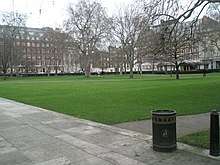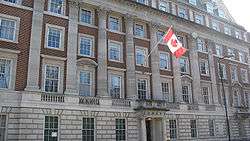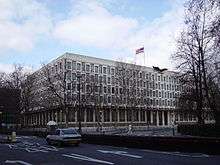Grosvenor Square

.jpg)
Grosvenor Square /ˈɡroʊvnər/ is a large garden square in the Mayfair district of London. It is the centrepiece of the Mayfair property of the Duke of Westminster, and takes its name from the surname "Grosvenor".
History
Sir Richard Grosvenor obtained a licence to develop Grosvenor Square and the surrounding streets in 1710, and development is believed to have commenced in around 1721. Grosvenor Square was one of the three or four most fashionable residential addresses in London from its construction until the Second World War, with numerous leading members of the aristocracy in residence.
The early houses were generally of five or seven bays, with basement, three main stories and an attic. Some attempt was made to produce impressive groupings of houses, and Colen Campbell produced a design for a palatial east side to the square featuring thirty Corinthian columns but this was not carried out and in the end most of the houses were built to individual designs. There were mews behind all four sides.
Many of the houses were rebuilt later in the 18th century or during the 19th century, generally acquiring an extra storey when this happened. Number 23 (later 26) was rebuilt in 1773–74 for the 11th Earl of Derby by Robert Adam, and is regarded as one of the architect's finest works and as a seminal example of how grandeur of effect and sophisticated planning might be achieved on a confined site. It was demolished and rebuilt again in the 1860s. Nearly all of the older houses were demolished during the 20th century and replaced with blocks of flats in a neo-Georgian style, hotels and embassies.
The Sursock family opened their first office in Europe at 31 Brook Street in 1858, from which they directed their commercial networks connecting land-holdings across the eastern Mediterranean to European markets and credit.[1]
In the 1920s, four of the Bentley Boys – Woolf Barnato, Tim Birkin, Glen Kidston and Bernard Rubin – took adjacent flats in the fashionable south-east corner of the square, where their day-long parties became something of social legend. So common was the sight of their large, green sports cars parked ad hoc outside their flats, that for many years London cab drivers referred to the spot as "Bentley Corner".
The central garden, which was originally reserved for the use of the occupants of the houses as was standard in a London square, is now a public park managed by The Royal Parks. At the eastern end of the garden there is a small memorial dedicated to the British victims of the September 11 attacks. The memorial includes an elliptical granite block engraved with the names of the victims and the poem For Katrina's Sun-Dial, by Henry van Dyke.
American presence

Grosvenor Square has been the traditional home of the official American presence in London since John Adams established the first American mission to the Court of St. James's in 1785. Adams lived, from 1785 to 1788, in the house which still stands on the corner of Brook and Duke Streets.
During the Second World War, Dwight D. Eisenhower established a military headquarters at 20 Grosvenor Square, and during this time the square was nicknamed "Eisenhower Platz". Until 2009, the United States Navy continued to use this building as its headquarters for United States Naval Forces Europe. A statue of Franklin D. Roosevelt, sculpted by Sir William Reid Dick, stands in the square, as does a later statue of Eisenhower and later one of Ronald Reagan.[2] The square also contains the Eagle Squadrons Memorial.
The former American Embassy of 1938–1960 on the square was purchased by the Canadian government and renamed Macdonald House. It was part of the Canadian High Commission in London until 2014, when all the functions of the Canadian High Commission were transferred to Canada House in Trafalgar Square.

In 1960, a new United States Embassy was built on the western side of Grosvenor Square. This was a large and architecturally significant modern design by Eero Saarinen but at the time it was a controversial insertion into a mainly Georgian and neo-Georgian district of London. In March and October 1968, there were large demonstrations in the square against US involvement in the Vietnam War. On both occasions, the protest became violent.[3] Since 2001, a series of anti-terrorist devices have been installed around the embassy, and the road running along the front of the embassy has been closed completely to traffic. In 2006, the Grosvenor Square Safety Group residents association took out advertisements in The Washington Post and The Times, accusing the Metropolitan Police and local government of a "moral failure" for not closing two other roads adjacent to the embassy.[4]
In 2008, the United States Government chose a site for a new embassy in the Nine Elms area of the London Borough of Wandsworth, south of the River Thames. Construction of the new Embassy of the United States in London began in 2013, with relocation completed by 2017. In October 2009, following a recommendation by English Heritage, the building was granted Grade II listed status.[5] The listing means that the new owners will not be allowed to change the facade, which includes the 35-foot-wingspread gilded-aluminium eagle that hovers above the main entrance. In November 2009, the Grosvenor Square property was purchased by the Qatari Diar investment group.[6]
Adlai Stevenson
On 14 July 1965, walking with Marietta Tree, then-U.S. Ambassador to the United Nations, Adlai Stevenson suffered a heart attack, later dying at St George's Hospital. As they reached the front of the Sportsman's Club, his last words were reportedly to ask her to slow down.[7]
Oscar Wilde
The writer Oscar Wilde lived in Grosvenor Square between 1883 and 1884[8] and references to the square appear in four of his works (see section below).
9/11 memorial
In 2003, a memorial garden in Grosvenor Square was dedicated to 67 British victims of the 11 September 2001 terrorist attacks.[9] A poem by Henry van Dyke was chosen for inscription on a memorial stone, underneath which is buried a piece of the steel wreckage.
Diplomatic property sell-off
The former US Navy building at 20 Grosvenor Square was sold in 2007 to Richard Caring for £250m, who planned to turn it into 41 residential apartments. The Abu Dhabi Investment Corporation and property developer Finchatton then bought the building for the same amount (£250m) in April 2013, with planning permission to convert the building into 31 luxury apartments.[10][11]
In September 2013, the Government of Canada announced its intention to sell its High Commission building at One Grosvenor Square and "consolidate its diplomatic activity in the UK in a single, central location in Canada House on Trafalgar Square".[12] Since then, Indian real estate group Lodha has demolished the building and is in the process of creating a new, high-end residential development.[13]
Notable buildings
- No. 1 – Macdonald House, formerly part of the High Commission of Canada,[14] being redeveloped into high-end residences[11]
- No. 4 – Back entrance to the Embassy of Italy
- No. 10 – London Marriott Hotel Grosvenor Square
- No. 20 – Former US Navy building, being redeveloped into upscale apartments[11]
- No. 24 – Eero Saarinen-designed former location of the Embassy of the United States,[15] being turned into a luxury hotel designed by David Chipperfield[11][16]
- No. 38 – Former Embassy of Indonesia,[17] converted by Venue Lab into an event space[18]
- No. 44 – Millennium Hotel Mayfair
In popular culture
- Robert Hunter's lyrics for the Grateful Dead song Scarlet Begonias begin with the line "As I was walkin' 'round Grosvenor Square".
- It appears in the title of several novels including The Lonely Lady of Grosvenor Square by Mrs. Henry De La Pasture (1907), The Grosvenor Square Goodbye by Francis Clifford (1978), and The House in Grosvenor Square by Linore Rose Burkard (2009).
- In Little Dorrit by Charles Dickens the Barnacles are said to live at "four Mews Street Grosvenor" which "was not absolutely Grosvenor Square itself but it was very near it".
- In the opening act in the play An Ideal Husband by Oscar Wilde, the first scene is in 'The octagon room at Sir Robert Chiltern’s house in Grosvenor Square.'
- It appears in the play The Importance of Being Earnest by Oscar Wilde when Lady Bracknell makes the comment about violence in Grosvenor Square because of the lower classes (or, depending on one's sense of humour, the upper classes) receiving education. This same comment is made in the 2003 film The Importance of Being Earnest by Lady Bracknell, who is played by actress Judi Dench.
- In Oscar Wilde's play Lady Windermere's Fan, the Duchess of Berwick says, "I think on the whole that Grosvenor Square would be a more healthy place to reside in. There are lots of vulgar people live in Grosvenor Square, but at any rate there are no horrid kangaroos crawling about."
- Dorian Gray, the protagonist in Oscar Wilde's novel The Picture of Dorian Gray, lives in or close to Grosvenor Square.[19]
- Alfred Sutro's one-act play A Marriage Has Been Arranged (1904) portraits a ball in "the Conservatory of No. 300 Grosvenor Square".
- Caroline Bingley makes a comment regarding the local dance in Pride and Prejudice "We are a long way from Grosvenor Square, are we not, Mr Darcy".
- It is used as a reference to the CIA's London office in the BBC spy drama Spooks.
See also
References
- ↑ Alff, Kristen (January 2018). "Levantine Joint-Stock Companies, Trans-Mediterranean Partnerships, and Nineteenth-Century Capitalist Development". Comparative Studies in Society and History. 60: 150–177.
- ↑ Video: Britain's Roosevelt Memorial at Grosvenor Square, 1946/11/28 (1946). Universal Newsreel. 1943. Retrieved 20 February 2012.
- ↑ "On This Day – 17 March – 1968: Anti-Vietnam demo turns violent". bbc.co.uk. BBC News. 2008. Retrieved 2 January 2015.
- ↑ "Embassy neighbours 'sacrificed'". BBC News. 27 July 2006. Retrieved 21 August 2013.
- ↑ "United States of America Embassy, Grosvenor Square". English Heritage. 22 October 2009. Retrieved 21 August 2013.
- ↑ "Qatar buys the American Embassy in London". The Daily Telegraph. 3 November 2009. Retrieved 21 August 2013.
- ↑ Kenneth S. Davis (1967). The Politics of Honor: A Biography of Adlai E. Stevenson.
- ↑ Wilde, Oscar; Bristow, Joseph (2005-01-01). The complete works of Oscar Wilde 3. 3. Oxford: Oxford Univ. Press. p. 419. ISBN 0198187726.
- ↑ Grosvenor Square Memorial Garden
- ↑ "Navy Deal Sealed: Finchatton and Abu Dhabi complete on £250m Grosvenor Square". PrimeResi.com. 4 June 2013. Retrieved 27 September 2013.
- 1 2 3 4 "Why Grosvenor Square is set to be London's number one residential address again". www.telegraph.co.uk. Retrieved 2018-10-03.
- ↑ "Canada to sell One Grosvenor Square". PrimeResi.com. 6 September 2013. Archived from the original on 10 September 2013. Retrieved 27 September 2013.
- ↑ "London's Most Desirable Address, No.1 Grosvenor Square". www.amara.com. Retrieved 2018-10-02.
- ↑ "The London Diplomatic List" (PDF). 14 December 2013. Archived from the original (PDF) on 11 December 2013.
- ↑ "The London Diplomatic List" (PDF). 14 December 2013. Archived from the original (PDF) on 11 December 2013.
- ↑ "24-31 Grosvenor Square". www.london.gov.uk. Retrieved 2018-10-03.
- ↑ "The London Diplomatic List" (PDF). 14 December 2013. Archived from the original (PDF) on 11 December 2013.
- ↑ "38 GROSVENOR SQUARE". Venue Lab. Retrieved 2018-10-04.
- ↑ Wilde, Oscar; Bristow, Joseph (2005-01-01). The complete works of Oscar Wilde 3. 3. Oxford: Oxford Univ. Press. p. 419. ISBN 0198187726.
- Summerson, John (2003). Georgian London. Yale University Press. ISBN 978-0-300-08988-2.
- Gear Wheels: The online motoring magazine. "Bentley Boys". Retrieved 13 February 2007.
External links
- Grosvenor Square at Curlie (based on DMOZ)
- Introductory page from the Survey of London – the subsequent pages cover the past and present buildings in great detail.